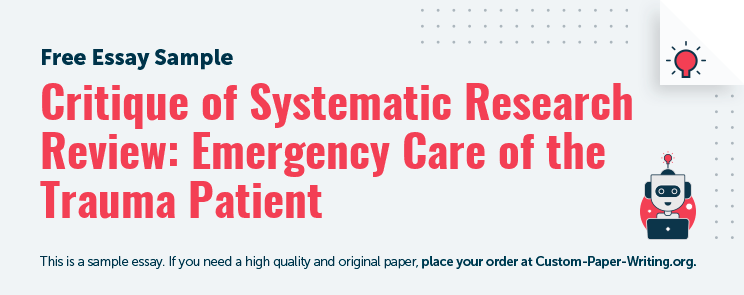
The Relevancy of the Research Problem to Practice
Nowadays trauma turns to be a global public health problem due to causing millions deaths to the world population per year (Byass et al., 2013). Unfortunately, it will take the primary place in the mortality rate statistics in the foreseeable future. Trauma-related deaths are rated the fourth in the mortality rate in the United States and take the leading position in the list of lethal outcomes of young and adult persons above the age of 45 (Hamilton & Hodge, 2011). According to the data of the World Health Organization (2011), in general a polytrauma in noncombat conditions is mainly a result of falls (37.3 million), road traffic accidents (24.3 million), violence (17.2 million) and fires (10.9 million). At the end of the twenties century, the USA and Western European countries implemented a system of the treatment of patients with polytrauma, providing maximum specialized help based on the vertical connection. In the USA, paramedics provide emergency care for injuries. The developed radio system gives them an opportunity to contact doctors and hospitals to call to a specialized trauma team. The issue of emergency care of trauma patients is an actual and important one, especially in nurses’ practice, because they are usually the first who deal with trauma victims. That is why, the enlargement of the knowledge of emergency care is very important in nurses’ practice. The purpose of the work is to analyze and review the literature concerning the emergency care of trauma patients. The review focuses on data of journal articles that estimate the validity of emergency measures applied to trauma patients. A comprehensive review was performed using electronic databases, such as Medline (2010-2015), CINAHL (2010-2015), and ProQuest (2010-2015). The following search terms were used in different combinations: “emergency care”, “trauma patients”, and “triage”. The lists of references of the chosen articles were also analyzed. This document addresses two main research questions, the problem of trimodal distribution and the term “golden hour” in emergency care of trauma patients.
Calculate the cost of essay
Critique of the Level of Evidence
The level of evidence of the researches under analysis is Level 4 because of the absence of control groups; they were based on the observation and analysis of a cohort of patients. It is necessary to mention that mainly all investigations into the topic of emergency care are very difficult to conduct using Level 1 evidence, because all of them concern accidents or extremal conditions, and it is nearly impossible to form a control group. The article with Level 3 evidence is the study by Seamon et al. (2015). The only way to increase the level of evidence is to compare the effect of different types of treatment or triage.
Critique of the Clarity and the Research Rigor of Articles
All articles analyzed in the work are academic and professional ones, taken from well-known scientific medical journals and containing valid information. The article entitled “Emergency Medical Services Intervals and Survival in Trauma” by Newgard et al. (2010) is too intelligible. It embraces the analysis of an enormous cohort of trauma patients of the United States and Canada who were transported by EMS to trauma centers of Level I or II. The criteria of patient inclusion are perspicuous as well as the criteria and methods of patient analysis and measurement. Primary data and sensitivity analyses were described very coherently. The limitations of the investigation, such as the absence of detailed hospital-based information, including injury severity score indexes of patients, insufficiency of the exact definition of time between an injury and admission to hospital are also coherently discussed in the article. Thus, this study is very useful for the analysis of the emergency care of trauma patients.
Limited time Offer
with code
The article by Gunst et al. (2010) has discussed trauma patients only of the Dallas country. That is why, it is rather difficult to transform their data to the whole cohort of trauma patients throughout the United States. They even show that the trauma-specific mortality rate in the Dallas county is lower than the national index. The authors even mark this finding as a limitation to the investigation, which can decrease its validity. In general, this article is rather pleonastic on the one hand, but it contains different diagrams, which are not clarified on the other hand.
The article by Hamilton and Hodge (2011) is a review devoted to the problem of the emergency care of trauma patients. They pay much attention to the problem of the operation of special trauma centers and describe different levels of their organization. The goal of this article is a clear description of special protocols for the examination of victim’s status during the first hour after an accident, including the ATLS (advanced trauma life support) protocol. The review is written very profoundly and contains extensive information concerning all stages and measures taken in the process of the emergency care of trauma patients. The main disadvantage of this article is the absence of exact statistics. The limitation of the work is not pointed out in the article.
Benefit from Our Service: Save 25% Along with the first order offer - 15% discount, you save extra 10% since we provide 300 words/page instead of 275 words/page
The article entitled “An Evidence-Based Approach to Patient Selection for Emergency Department Thoracotomy” by Seamon et al. (2015) is the best study because of its professionalism, profound analysis of literature, evidence-based data, qualified comparison of obtained data with the literature and a coherent explanation.
- Share this post with your friends:

